Dr. Jean Marry Exantus’ work has enabled us to record three additional bird species — Tachycineta euchrysea, Elaenia cherriei and Tyrannus Gabbii — one of which is found only in the Dominican Republic
Despite aggressive deforestation and socio-political unrest, Haiti is home to 288 bird species, 33 of which are endemic, making it one of the most biodiverse countries in the Caribbean.
These figures come from research carried out by Jean Marry Exantus, specialist in avifauna and holder of a doctorate in Ecology from the Université des Antilles in Guadeloupe.
Dr. Exantus’ work has enabled us to record three additional bird species — Tachycineta euchrysea, Elaenia cherriei and Tyrannus Gabbii — one of which is found only in the Dominican Republic.

Myadestes genibarbis = Zwazo mizisyen = Whistling musician. | © René Durocher
The 288 bird species are divided into 176 genera and 56 families, according to the researcher. Among them, migratory species number 171, accounting for 59.3%, resident species number 117, accounting for 40.7%, of which 33 are endemic.
Read also : Haïti ignore tout de ses espèces endémiques
While the biodiversity of Haiti’s ecoregions remains remarkable, many of the country’s species have seen their global status deteriorate over the years.
Of the 33 endemic bird species, 10 are threatened, of which 7 are vulnerable (VU), 2 are endangered (EN) and 1 species is critically endangered (CN), according to Jean Marry Exantus.
Read also : L’oiseau Kanson Wouj, emblème national d’Haïti, menacé de disparition
There are a number of converging factors behind the precarious status of these species. According to experts these include deforestation, urbanization and the associated pollution, agriculture, and climate change.
René Durocher is a wildlife photographer passionate about animal biodiversity in Haiti. With his camera in hand, he goes on expeditions all over the country to capture different species of birds, as well as amphibians on film.
Durocher explains to AyiboPost that hunting is one of the many threats facing avian species in Haiti. He says he has seen a hunter “about a year and a half ago” holding several woodpigeons in his hands, in the heights of the capital.
Read also : Photos | Wynne Farm : un joyau écologique en proie à l’insécurité et à la fermeture
The Trogon Damoiseau, also known as caleçon rouge or kanson wouj, is a bird endemic to the island. With its lively and piercing eyes, it sports a multicolored plumage.
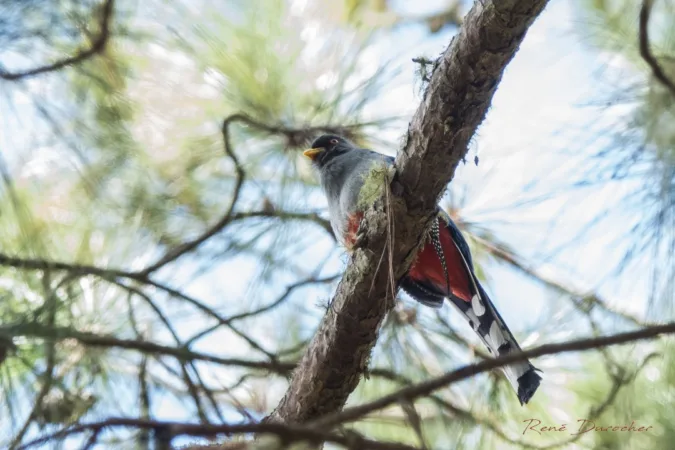
Priotelus roseigaster is commonly known as the Hispaniolan Trogon, locally referred to as « Kanson wouj, » « Caleçaon-rouge, » or « Dame-anglaise. » It is an endemic species and the iconic bird of Haiti. | © René Durocher
This animal resides mainly in the Selle and La Hotte ranges and is considered the national bird. It is scientifically nicknamed Temnotrogon Roseigaster and is found between 500 and 3000 meters above sea level. Due to hunting in particular, the kanson wouj is experiencing a “moderately rapid reduction” in its population and a gradual loss of its natural habitat, according to the International Union for Conservation of Nature (IUCN).
Founded in 1948, the IUCN is an intergovernmental organization that is responsible for nature conservation and assigns conservation status to species around the world, depending on their condition.
The kanson wouj is not the only species of serious concern. The Hispaniola crow (Corvus leucognaphalus), among others, is classified as “vulnerable”. Better known as kaw in Haiti, this bird – in the habit of startling the Haitian landscape with its garish tremolo, its black fur and which was found in various types of habitat, notably natural and wooded areas — has seen its population decrease year after year, according to Jean Marry Exantus.
This situation is all the more worrying as the kaw are now only found on the island of Haiti. The species has already become extinct in several countries, including Puerto Rico where it was last observed in 1977.
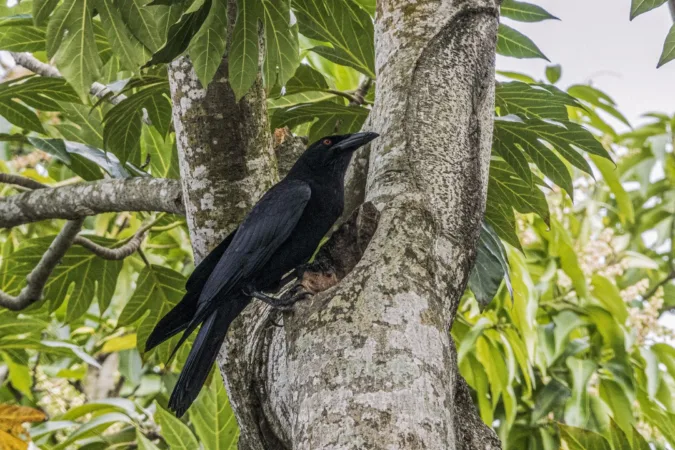
Corvus leucognaphalus = Gwo kaw, Gwo gra-gra, Endemic. | © René Durocher
Endangered species in Haiti include the La Selle thrush (Turdus Swalesi), the Crossbill (Loxia megaplaga), the Hispaniola parrot (Amazona ventralis), and the black-capped petrel, among others.
Only one species is threatened with extinction in Haiti: the malfini savann (Ridgway’s hawk), scientifically named Buteo ridgwayi.

Loxia megaplaga is commonly known as the Hispaniolan Crossbill, or « Bèk kwaze » in Haitian Creole. It is an endemic and threatened species. The specialized shape of its beak allows it to extract seeds from the cones of the Caribbean pine (Pinus occidentalis), promoting seed dispersal and contributing to the reproduction of pine forests. | © René Durocher
According to Dr. Exantus, this situation is partly due to urbanization, or human pressure on natural areas in urban environments.
“Territorial recomposition, where people deforest and destroy the rich flora to build houses or engage in agriculture, leads to deforestation which is not beneficial for bird species. By creating more space for cities, we are destroying the habitats where different species lived, » laments Dr. Exantus.
The destruction of a species’ habitat leads to a situation where the species in question is no longer able to find the nourishment it needs to feed itself, or the space where it can nest and reproduce properly.
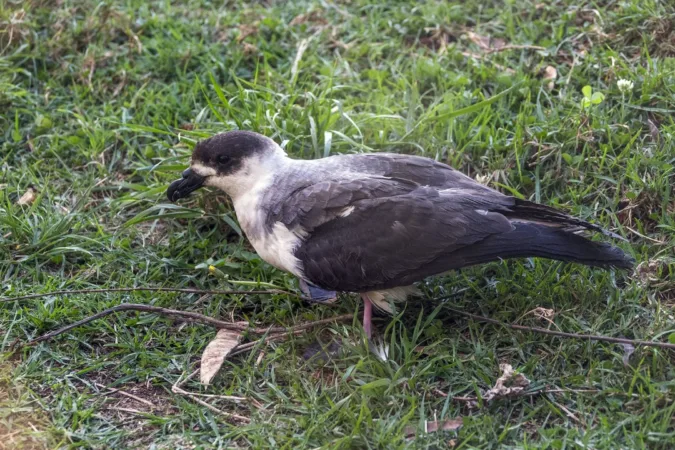
Pterodroma hasitata = Petrel diablotin, Chanwan, Kanan Lasèl. Critically Endangered. | © René Durocher
It is not clear whether insecurity plays a part in the decline of the bird population. “Perhaps insecurity is beneficial to birds, because due to this situation, people who hunt are no longer able to go hunting as they please,” analyzes René Durocher.
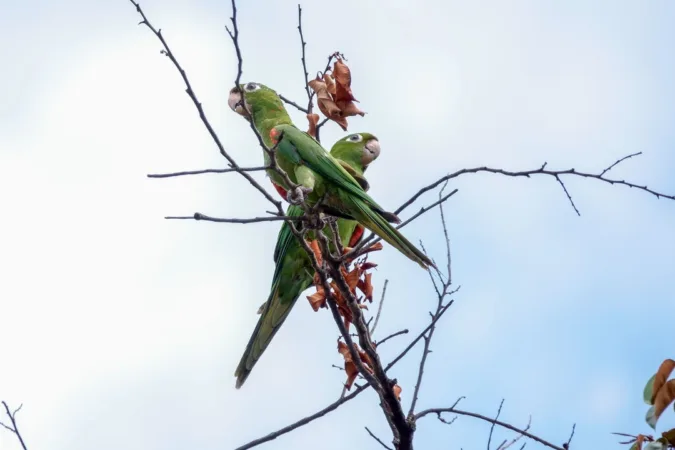
Psittacara chloropterus = Hispaniolan Parakeet, endemic. | © René Durocher
Waselin Salomon holds a doctorate in agricultural sciences and biological engineering from the University of Liège in partnership with the State University of Haiti (UEH).
For Salomon, as the population increases, it puts pressure on ecological systems, notably through agriculture, industrialization, etc. These actions contribute to the modification of the landscape. Which is not without consequences for biodiversity.
When a road is built in a landscaped environment, for example, this area finds itself split in two or fragmented.
“However, there are species of birds that need a specific surface area to flourish,” explains Salomon.
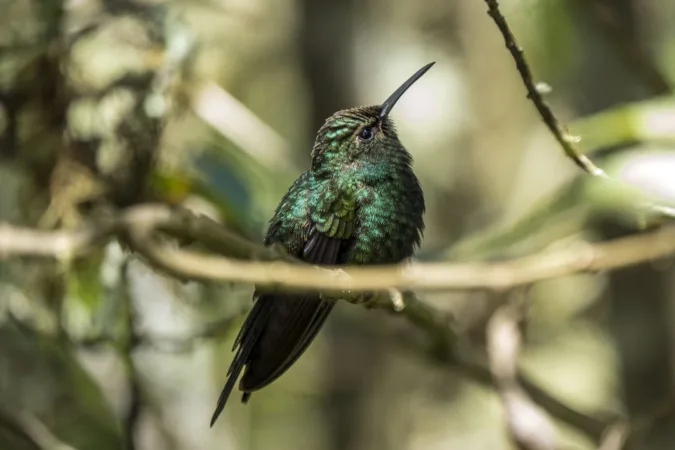
Riccordia swainsonii = Wanga negès mòn = Hispaniolan Emerald, endemic. | © René Durocher
The government has taken action to protect birds and their habitats in Haiti.
A rural code was put in place under the government of François Duvalier and a decree published on March 31, 1971 organizing the surveillance and policing of hunting on the national territory.
In January 2018, the Ministry of the Environment banned for an indefinite period the hunting, poisoning and trade of any bird species in the country.
But despite these measures, birds have never been exempt from the threats that human activities pose to them.
“The laws are certainly there, but we do not apply them,” says Dr. Jean Marry Exantus.
Efforts to conserve biodiversity also seem minimal. “In Haiti there has never been a national inventory or a general census to identify all the species that populate our land,” laments Exantus. Isolated expeditions in this direction are most often made by foreign researchers or organizations.
Haiti has a “Directorate of Biodiversity,” an agency of the Ministry of the Environment responsible for giving substance to the national policy for the protection and conservation, among other things, of the country’s species. Despite repeated requests, AyiboPost was unable to speak with Michelet Louis, the head of this department.
The Haitian government appears to be abandoning the issue. “The only natural history museum on the island is in the Dominican Republic,” adds Exantus.
© Cover image : Riccordia swainsonii = Wanga negès mòn = Hispaniolan Emerald, endemic. | © René Durocher
Stay in touch with AyiboPost through :
► Our WhatsApp channel : click here
► Our WhatsApp Community : click here
► Our Telegram canal : click here

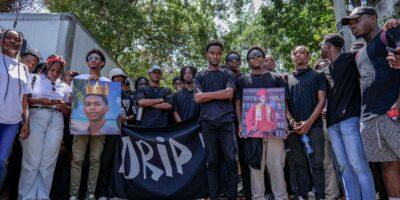





Comments